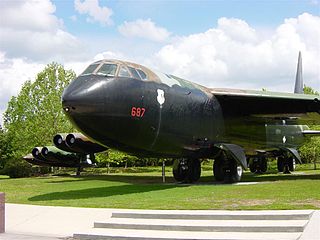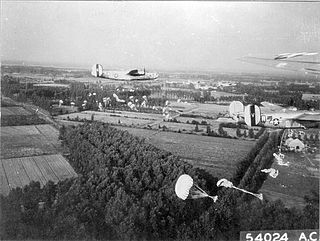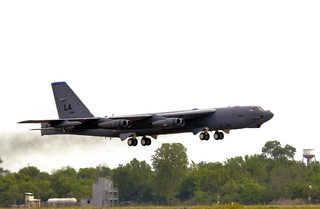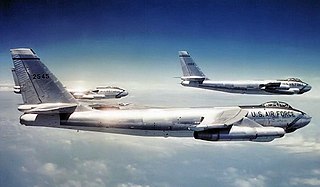
The 306th Flying Training Group is a unit of the United States Air Force, assigned to Air Education and Training Command (AETC). The group is stationed at the United States Air Force Academy (USAFA) near Colorado Springs, Colorado.

The 310th Space Wing is an Air Reserve Component (ARC) of the United States Air Force. It is assigned to the Tenth Air Force, Air Force Reserve Command, stationed at Schriever Space Force Base, Colorado. The wing is the only space wing in the Air Force Reserve. It provides specialized expertise, continuity and combat ready personnel. It is mission partnered with several United States Space Force deltas: Space Delta 2, Space Delta 3, Space Delta 4, and Space Launch Delta 30.

The 306th Strategic Wing, previously the 306th Bombardment Wing, is an inactive United States Air Force unit. It was last assigned to the Strategic Air Command at RAF Mildenhall, Suffolk and was inactivated on 1 February 1992. The wing's mission was to coordinate all SAC air refueling and reconnaissance resources in the European Theater with the United States Air Forces in Europe (USAFE). It assumed the mission of the 98th Strategic Wing when that unit was inactivated in 1976.

The 512th Rescue Squadron is part of the 58th Special Operations Wing based at Kirtland Air Force Base, New Mexico. It formerly operated the Bell UH-1N Twin Huey and currently operates the Sikorsky HH-60G Pave Hawk and the new HH-60W Jolly Green II helicopters training aircrew conducting search and rescue missions.

The 2d Bombardment Squadron is an inactive United States Air Force unit. Its last assignment as a Boeing B-52 Stratofortress squadron was with the Strategic Air Command 22d Bombardment Wing stationed at March Air Force Base, California. It was inactivated on 1 October 1982. The unit was redesignated as the 2d Strategic Squadron as a Boeing KC-135 Stratotanker rotational squadron with the 306th Strategic Wing and was last active at RAF Mildenhall, England in 1992.

The 506th Bombardment Squadron is an inactive United States Air Force unit. It was last assigned to the 44th Bombardment Wing at Chennault Air Force Base, Louisiana, where it was inactivated on 15 June 1960.

The 513th Electronic Warfare Squadron is a United States Air Force unit assigned to the 350th Spectrum Warfare Group at Eglin Air Force Base, Florida.

The 329th Combat Crew Training Squadron is an inactive United States Air Force unit. It was last assigned to the 93d Operations Group at Castle Air Force Base, California, where it was responsible for the training of Boeing B-52 Stratofortress aircrews until inactivating on 1 July 1994.

The 330th Combat Training Squadron is a United States Air Force unit assigned to the 461st Air Control Wing based at Robins Air Force Base, Georgia.

The 487th Bombardment Squadron is an inactive United States Air Force unit. It was last assigned to the 340th Bombardment Wing at Whiteman Air Force Base, Missouri, where it was inactivated on 1 September 1963. The squadron was first activated during World War II. After training in the United States, it deployed to the Mediterranean Theater of Operations, where it flew North American B-25 Mitchell medium bombers, primarily on air support and air interdiction missions, earning two Distinguished Unit Citations for its actions. After V-E Day, the squadron returned to the United States, where it was inactivated in November 1945.

The 340th Weapons Squadron is a United States Air Force unit assigned to the USAF Weapons School. It is stationed at Barksdale Air Force Base, Louisiana. The 340th is assigned to the 57th Wing, at Nellis Air Force Base, Nevada. The mission of the squadron is to provide Boeing B-52 Stratofortress instructional flying.

The 423d Bombardment Squadron is an inactive United States Air Force unit. Its last assignment was with the 306th Bombardment Wing at MacDill Air Force Base, Florida.

The 367th Training Support Squadron, located at Hill Air Force Base, Utah. It is a component squadron of the 782nd Training Group; part of the 82nd Training Wing at Sheppard Air Force Base, Texas.

The 368th Training Squadron is a United States Air Force ground training unit, located at Fort Leonard Wood, Missouri. The squadron reports to the 782d Training Group, part of the 82d Training Wing, at Sheppard Air Force Base, Texas and conducts training for airmen in civil engineering, as well as in Logistics Readiness in Ground Transportation.

The 441st Air Expeditionary Squadron is a provisional United States Air Force unit. It was converted to provisional status in May 2011.

The 353d Bombardment Squadron is an inactive United States Air Force unit. It last was assigned to the 301st Bombardment Wing, stationed at Lockbourne Air Force Base, Ohio. It was inactivated on 8 June 1964.

The 352d Bombardment Squadron is an inactive United States Air Force unit. It was last assigned to the 301st Bombardment Wing at Lockbourne Air Force Base, Ohio, where it was inactivated on 8 June 1964.

The 341st Bombardment Squadron is an inactive United States Air Force unit. It was last assigned to the 4038th Strategic Wing. It was last stationed at Dow Air Force Base, Maine, where it was inactivated on 1 February 1963.

The 342d Bombardment Squadron is an inactive United States Air Force unit. It was last assigned to the 4137th Strategic Wing at Robins Air Force Base, Georgia, where it was inactivated on 1 February 1963.

The 366th Bombardment Squadron is an inactive United States Air Force unit. It was first activated in March 1942. After training with Boeing B-17 Flying Fortress bombers in the United States, the squadron deployed to the European Theater of Operations, where it participated in the strategic bombing campaign against Germany. The squadron was twice awarded the Distinguished Unit Citation for its combat actions. Following V-E Day, it moved to the continent of Europe and engaged in photographic mapping until inactivating in December 1946.





















